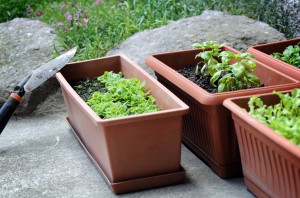 Small Space and Container Gardening: Tips, Tricks, and Best Varieties
Small Space and Container Gardening: Tips, Tricks, and Best Varieties
Small on space but big on gardening? A lot can happen in a small space. With some creativity and the right varieties, a small space can offer a big yield. Botanical Interests Seed, just one of the many seed brands carried by Foreman’s General Stores, has a number of wildflower seed varieties to choose from. This high quality USDA Certified Organic seed is untreated with over 600 varieties, including many heirloom seed varieties with no GMOs. Here’s some tips from Botanical Interests Seeds to help you get started on your small garden project:
Tips to make the most of your space
Grow up!
Growing vertical is an efficient use of space for vines like tomatoes, beans, squash, melons, cucumbers, and peas. Using trellises, cages, and fencing also saves your knees, increases airflow to plants, reducing the risk of fungal diseases, and puts harvest within arms reach.
Smart spacing
Sow for two harvests at once. For crops that offer a one-time harvest like carrots or radishes, sow and thin to half the final suggested spacing. Harvest every other plant when they are half grown for baby carrots and beets. Sow radishes between rows of slower maturing crops like carrots. Quick to sprout radishes not only mark where you’ve planted and where you need to water, but will be harvested before the other crop is large enough to feel crowded. Also, planting in a staggered triangular pattern is more space efficient than rows or squares.
Start indoors
Many crops can be started by seed indoors and transplanted out shortly after. This can save a month or more of time in the garden bed, leaving room for something else to mature.
Extend your season Using protection like row covers, walls of water, or plastic low tunnels may allow you to transplant or sow a month earlier than usual in the spring and extend the season in the fall, keeping a small space producing.
How to grow in containers
Soil
Your container potting soil (media) is really important. If you’re having a hard time choosing, pick one that is labeled for containers. It will hold the right amount of water, nutrients, and air to ensure the healthiest possible plants. Some potting soil comes with compost or slow-release fertilizer incorporated right into it; consider this when evaluating cost.
Container
Plan your container according to the size of plants you want to put in it. Even plants in containers need room to grow. A bit of crowding can work, but don’t overdo it. Overcrowding can cause water stress, reduce airflow, and increase competition for light and nutrients. Stress and over-fertilization leaves plants susceptible to pest and diseases. Want to use a really big container but don’t want to use tons of soil? 12”–18” is plenty deep for most plants. You can also turn over a plastic or clay pot in the bottom to displace some of the soil. You’ll save on potting soil and water, and your container will weigh less, too.
Water and Fertilizer
Keep in mind, containers that are really full, very small, or in sunny and windy places will need water more often. Watering in the morning to prevent stress is best. Healthy, stress-free plants will stay productive and flower longer. Container plants need regular feeding. If your potting soil doesn’t contain fertilizer, add a slow-release fertilizer, or regularly feed with a water-soluble fertilizer.
Great container varieties
Don’t rule out crops you thought were too big for containers. A larger container can grow summer squash or even some bush-type winter squashes and cucumbers like Gold Nugget Winter Squash and Spacemaster Cucumber just fine! The same goes for root crops like beets and carrots. Use a deeper pot for these delicious roots and choose a small variety like Tonda di Parigi Carrots, or harvest beets at a smaller stage. Add Alyssum too for color and fragrance while attracting beneficial insects and pollinators. You can also add Five Color Silverbeet Swiss chard or Ruby Streaks Mustard for beautiful, edible color and texture to decorative container plantings.
Search the Botanical Interest’s website to find varieties that thrive in small spaces and containers. Then, visit us at Foreman’s General Store to pick up seeds, containers, fertilizer and anything else you need!
Source: Botanical Interests Seeds



